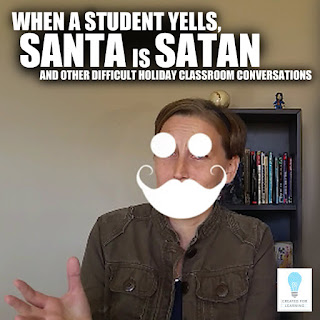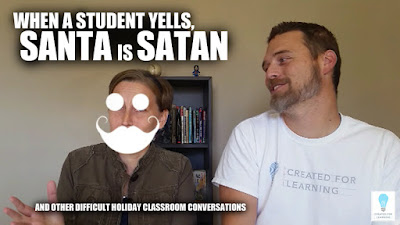Today, we’re gonna talk about When Your Student Yells, “Santa is Satan!” and Other Holiday Respect Conversations.
Watch the YouTube video here >>> https://youtu.be/MBUodyYaCG0
Christmas time! Yay!
No … it’s Happy Holiday time.
But what if it isn’t “happy” for me?
What’s not happy about snow days?
I grew up in California where there isn’t really “winter” and we never got any of your stupid snow days.”
Oh, as teachers how do we handle this?! We are going to share some of our thoughts and experiences from holidays in the classroom. The hope with this is not to tell you what you should be doing in the classroom but to get you thinking about how you handle the holidays and the effect it has on your students and the classroom environment as a whole.
This topic can get heated because there are some strong beliefs involved with the “Holiday Season” and when it comes down to it causes us to question our own personal truth about our existence. If we let it.
Let’s not get that deep right now. Let’s just focus on some basics. We as teachers get to decide how we want to direct our classroom environment to be.
The decision is affected by whether you teach at a public or private school. If you teach at a religious private school the decision may be easier for you. If you are at a public school that doesn’t have administrative restrictions, you get to decide if you are going to try to represent all holiday traditions in your classroom or are you going to avoid teaching about any holiday themes.
In elementary school we are often with the same group of kids so you might have time to integrate themes into your classroom more extensively.
With secondary I had lots of students for a shorter periods of time.
I’m the type of person that tends to be hyper-sensitive to the complexities of situations or possible complexities. So for my peace of mind and attempt to decrease my stress, I chose not to teach holiday traditions.
So what complexities do you identify with the holiday season?
Identifying all the holiday traditions that my students could possibly celebrate while not unintentionally offending anyone with how they are represented.
I can think of: Hanukkah, Kwanzaa, Christian Christmas with Jesus, secular Christmas with Santa, a mixture of both, people that don’t celebrate anything, and people that don’t celebrate things, like Jehovah’s Witnesses.
I avoided all that stress on myself and just kept my classroom winter-themed with snowmen and snowflakes. I like snowmen.
Snowmen or snowpeople?
Ok, snowpeople.
Anyway, I taught first and second grade and even though I just integrated fun winter themes into our classroom activities, holiday always came up when kids talked about life. So during casual student discourse things always came up:
- there was always some variation of a conversation about Santa not being real, that is often debated in the lower grades,
- or even if a child believed in Santa, another student told them, “You’re going to Hell!” . . . yes, more than once that was said.
- Talks about Jesus being real
- Whatever the variation of the conversation, these were distressing to the students involved in the conversation.
Usually I only needed to address it with the small group of students that were involved in the discussions. I think one year I needed to address it as a whole class because there was a particularly passionate and vocal student about their personal worldview being right.
I would love to hear other teachers’ stories of how they handle these situations. I tried to model listening that showed people were heard and respected.
Don’t take sides! You are the mediator.
You are the teacher, you are neutral (unless you are at a private school where your beliefs are accepted as the dominant belief).
In this world lots of people believe different things and celebrate differently. It’s interesting to learn about each other and how we live life. We want to remember to always show respect to each other. I would ask them if they wanted the other student to make them feel bad for what they believe, they would say no. So I reminded them to treat each other the way they wanted to be treated.
The possibly more distressing example, “Santa is Satan!” (In secondary grades, this morphs to “Santa anagrams to Satan … they have all the same letters” to which I would answer, “Yes, and Britney Spears anagrams to Presbyterian! Is that supposed to mean something?”) To which they reply, “Who’s that?” “Wait, is she that crazy old mom lady who shaved her hair?”
I’d leave the Santa is Satan situation to a one-on-one conversation with the student.
When I was asked bluntly by students during school hours, I tried to switch to questions about their beliefs. I used redirection. Example: Is Santa real? Me: Do you celebrate Santa? Does Santa bring you gifts? Etc. Most students didn’t realize I didn’t answer. Or I would just say those are conversations they can have with their parents.
- Identify that they have different views or experiences.
- Tell them it is important to show kindness and respect.
Basically I taught them to either respectfully ask each other about what they believe OR agree to disagree and change the subject.
Always remember there are most likely parents or guardians represented by each of these students and imagine they are hearing what you are saying to their children and whether they will approve. I often told students to talk to their parents about whatever topic distressed the student.
Can you defend your approach to how you addressed the disagreement in a way that will be acceptable to the parents and your administration?
If you need a quick out, you can redirect students to what they should be focused on but log the disagreement in your mind because things can brew from strong feelings from opposing views that aren’t talked through.
Conversation of the Day: Share a funny or cute or difficult holiday story that you had to work through.
Hop on over to watch the video and share your thoughts in the conversation.











